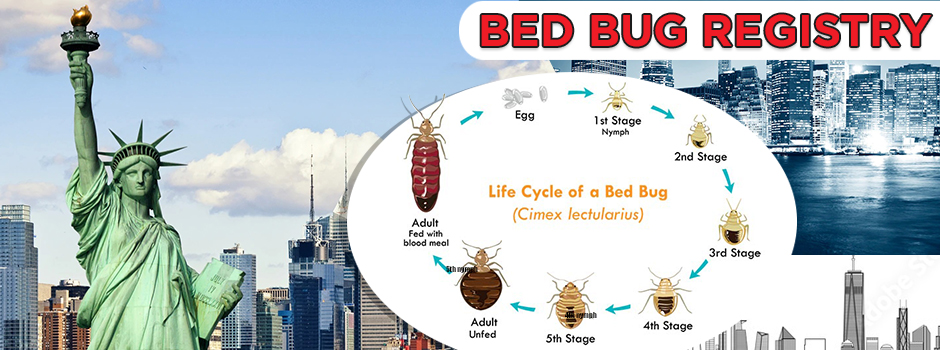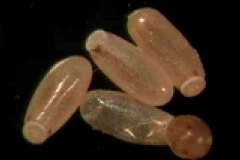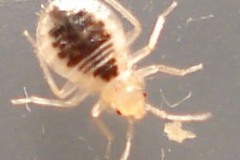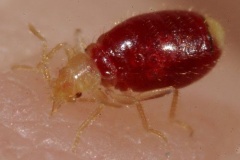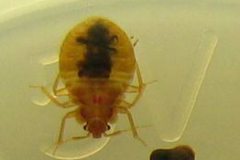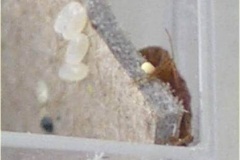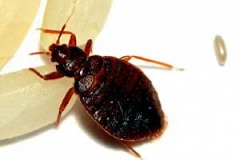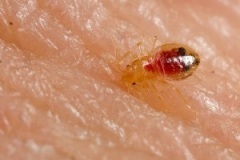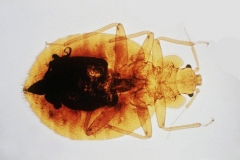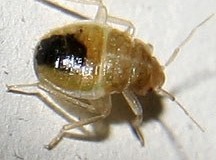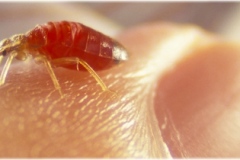Stayed her for 2 nights Febuary 26-27 2016 first night I had irritation thought I was maybe the detergent because I have very sensitive skin second night itching burning feeling on my legs & arms & br...
09/20/2019 0800 BED BUGS!! Room 216 Front desk didn't seem concerned. Manager didn't bother to call. I showed them pictures and video. ...
So there I was on nightshift working remotely from the hotel. The night had been long and I needed a nap to resume my duties and be fresh. Right as I made my way to the bed I saw a black dot on the be...
Checked in 1/15/2016 @ 9:30pm. An hour later my son was sitting on the sofa and saw something crawling on the arm of the sofa, we picked it up and examined it, confirmed it was a bed bug. We instantly...
Checked in at 11pm and were out off there by 2 am. The hotel room was old and the bedding was old and dated. Saw two bed bugs crawling on bed. Took photo and video. The hotel staff didn't do anythin...
We stayed here from July 30 to Aug 5th. At first I thought it was mosquitos in the evening while I out and about in Indy, but than I knew because I only felt the bites a short time after waking in th...
I stayed at the Hyatt Regency Indianapolis on May 22nd, 2017 in room 1621. I woke up in the middle of the night with two severe (bright red and hurtful) bites on my back. I didn't think of anything ba...
My stay was in December 14, 2015 for a week and the Hyatt was definitely impressive because it's a business center inside as well. Room I was upgraded to was nice once I checked in. Next morning I g...
Found a bed bug on my pillow at 6am. Squished it - blood on the pillow case. Found bites on my neck. Checked out ASAP. Told front desk. They comped the room (1night) cancelled the rest of my stay (...
7/18...Reported, they sent someone to look, said must of been previous...found dead bugs and blood stains, only offered half off....ridiculous...
7/29/17 6:15 pm Checked headboard first in room 313. Had many bedbugs in cracks. Went immediately to front desk and checked out. They offered another room but we declined...
Early Sunday morning around 6 am I found a bed bug crawling on one of the Queen sized beds. I captured it and took it to the front desk. The gentleman at the front desk looked at it and said..oh, sorr...
We were getting ready to head down for breakfast in the morning at 6 am....we saw a bed bug crawling on the top of the sheet on one of the Queen sized beds...I captured it and took it to the gentleman...
I saw a bug in my bathtub, took a look at it and was sure it was a bedbug. I put it down the toilet, and immediately told the hotel staff. They called in an exterminator, who confirmed that the room ...
As a disclaimer, the staff was very polite and accommodating to our needs throughout the whole stay. I requested a new room, because the dust and dirt in the first room was so overwhelming that my al...
I checked into my room around 7pm on May 17th, 2015.I then dropped my luggage off and left to run errands. When I returned. I showered, then sat on the bed to watch TV. Around 11pm I turned down the b...
My son woke up covered in red welts. The manager insists they do not have a problem. I found online other people having the same experience at this place. My son has bites on his face and neck fron...
We stayed in this hotel overnight on 6/26/2016. I went to get in the shower after sleeping on the fold out couch, and when I took off my shirt I found a bed bug on my chest. I killed it and woke up ...
Hotel looked clean upon inspection, but two hours later we found a bed bug crawling on the bed. Told staff and we were basically ignored. Also found one downstairs in lobby area on couch it was dead,...
I was staying in the candle wood hotel in Indianapolis for business and Im out of state. While in room 222 on 12/26/17 I felt something crawling on my arm. Turn the lights on and it was a bed bug. An...
I woke up in the middle of the night to see bed bugs. I counted at least 4 bugs visible to the eye, without actively searching. Management moved me to another hotel. However, throughout the entire pro...
We stayed in room 601 with our 2 year old daughter for two nights in April of 2019. The first night I received a bite on my right leg but thought it must have come from elsewhere. The second night how...
My husband awoke from a nap and a BED BUG was crawling on his shoulder on 9/30/17 at 7:37pm!!! He brought it to our attention and we took it downstairs in a cup. The front desk acted like this has hap...
Bugs found 6/12/15, son suffered over 30 bites. Manager informed and saw actual bugs for himself. Moved to new room....
Visited in June of 2019. Checked for bugs via typical inspection methods. Woke up itching. Found 2 bed bugs on pillowcase; killed one and put other in bag for inspection assistance. Completed further ...
We noticed 4 big bed bugs we informed the manager Ali he was very rude and disrespectful I wouldn't recommend this place to anyone it's nasty and totally unsafe unsanitary...
Stayed here check in was Thursday 04/11/2019 got in room and we smelled a strong bug spray smell upon entry we werent sure why when asked front desk they said it possibly pool as our room was acros...
January 14th 2017 My Grandma moved in here 3 months ago and never had issues with bed bugs before. Now grandma has huge red spots all over her. She told management and they told her that she had ove...
I have lived here since March and since then we have seen many trucks, more recently. I have spoken to a few neighbors and one has had to get her apartment fumigated 3 times in a year because of bed b...
As stated by the previous commenter there is something in the lease that puts all responsibility on to the tenant because they know about the infestation but refuse to address it which creates a bigge...
This is twice in 6 years i have had bed bugs. 2010 and 2015. The first time the adjacent apartment was infested n the tenants moved out without notifying office. It was not exterminated. They moved a ...
I checked in on 1/4/16 and found a live bed bug on 1/7/16. The manager confirmed they had found a bed bug in my room 166, she called me later to inform me the exterminator had found several more in my...
Bed bed crawled on me as I awoke and after a shower I found one crawling up the comforter - I put the bed in a cup and reported to the front desk - verified it was two bed bugs...
BED BUGS Holiday Inn Express Indianapolis-Southeast I had reservations for the Holiday Inn Express Indianapolis-Southeast on Sat, May 16th 2015. We arrived in the late afternoon, checked in, and we...
The room I stayed in was infested with bed bugs, life, and fleas. Do not ever stay there. absolutely the worst place ever....
My baby daddy and I rented the motel for a week. Which costs us $180. $170 for the week and a $10 key deposit. There was no remote to the tv. The phone didn't work and we believe someone had came in ...
Bed bugs in room.manager refused to move us to another room.they actually said sleep with the lights on and they won't bites...
I was staying in a room where I found 1 bed bug in the bathtub. They had treated the room twice the week before. They moved us to a different room and gave me quarters to use the washer and dryer....
Bed bug was discovered in bathroom on towel. Adult non fed. Found before leaving in morning. Brought bug to front desk and they did nothing. Acted like it wasn't a bed bug. ...
We stayed there last night and woke up this morning, while I was sitting on our bed with my baby I saw a bug crawl across the bed. My husband trapped it in a cup and took a picture of it. Then he we...
We stayed at the Comfort Stay Inn April 22-23. We were in town for a baseball tournament and had no choice of where to stay. We were in room 205. We woke up after the first night to find a bug crawlin...
My daughter and her boyfriends apartment is infested with bed bugs and they are not in any hurry to help resolve the problem. They had to throw away their bed and living room furniture and have no wh...
On November 3- 5th me and several coworkers were staying at this hotel. We had heard of prior bed bug issues from other coworkers but still stayed at the hotel. When we actually witnessed bed bugs in ...
I know for a fact that there are more than 10 rooms out of order because management/owners will not pay for the professional services. They are putting employees and guests in a health danger to save ...
I phoned the leasing office to have the uncomfortable conversation about finding bedbugs in my unit. I asked if any other tenants reported a bedbug issue and was told, "I can only see your account on ...
We stayed at this hotel as a team for a volleyball tournament 3/31-4/2 and at least 3 rooms were infested. Management tried their best to relocate families to other rooms and offer refunds, etc. Not g...
6/14 @ 6:14 am I was awakened due to itching. I turn on the light and see bedbugs all in the bed. Plus there's a hole in the wall with a small infestation of them. Management has been notified on seve...
3/17/19 Checked into hotel, when we pulled sheets back there was blood on pillow case and on sheets. It was around 10 pm when we realized it. So they brought us new sheets, that I had to put on. The ...
Recommended tips after hotel check-in: 1. Pick up the mattresses in the rooms and look under it. Check around the edges of the box springs. 2. Check under the box spring. 3. Lift up each headboard an lie it on the bed. Carefully inspect the hole where the headboard was lifted out of. Also, inspect all niches and corners of the headboard. 4. If you decide to stay in the hotel, do not put any clothes in dressers. Keep them in your luggage and your dirty clothes in plastic bags.
See more here:
Indianapolis, Indiana Bed Bug Reports

 Residence
Residence  Location
Location 
